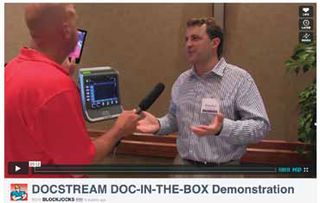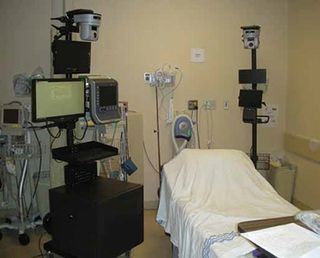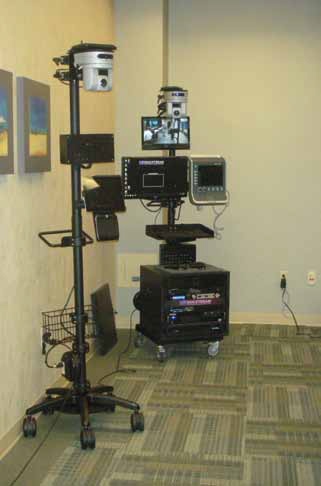From the bedside to the cloud: medical education is transforming.
At its core, the DOC-IN-THE-BOX unit consists of a pair of customized pole carts. The ClarkPowell team installed a 19-inch equipment rack in the base of the primary cart for the switcher/scaler, and a Windows-based
CPU. The primary cart also houses an ultrasound machine with built-in display, two HD displays, and a Vaddio HD-PTZ camera. The secondary cart holds an additional HD-PTZ camera and an iPad, which controls the system. All of these components interact wirelessly.When he’s not performing ultrasound-guided regional anesthesia, Dr. Brandon Winchester likes to teach others how to do it. For the past several years, he has traveled from his home base at the Andrews Institute in Gulf Breeze, Florida, to observe and teach—also called proctoring—other physicians and nurses as they learn new techniques in this specialty. But, he says, he ran into a problem with this training method. “I couldn’t get out and reach enough doctors who needed this education,” he said. Being reasonably tech-savvy, Winchester set his mind to devising a new model for delivering medical education through cloud-based solutions.
Barriers to teaching and learning
The traditional model of medical training presents several key barriers to effective education in regional anesthesia. First, as Winchester said, he and other instructors can’t reach enough practitioners each year. Spending a week in a facility, Winchester might be able to proctor half a dozen physicians and nurses. And he only has so many weeks per year to spend teaching.
Second, doctors benefit from seeing a single procedure performed over and over again. This repetition allows them to get a good grasp of all the steps involved in administering specific nerve blocks. In a proctoring situation, the teaching doctor may demonstrate several different procedures in a row. Moving quickly from one type of procedure to another doesn’t give the physician or nurse watching the demonstration enough experience to achieve a high level of proficiency.
Third, many medical professionals don’t have time for in-person proctoring. They would benefit from the availability of high-quality videos to watch on the web at their convenience, as many times as desired.
Building a solution
Assessing all these barriers to effective education in regional anesthesia, Winchester began dreaming up a solution. His goals were relatively lofty for an anesthesiologist who only dabbled in video production. Foremost, he wanted a way to reach more doctors. He felt high-quality on-demand videos could help in this regard. But Winchester wanted to go beyond studio-produced lectures. His vision included using multiple cameras to stream live procedures to the web. Since no product existed that would allow him to do all of this, he knew he would have to build his own solution. So that’s what he did. He literally went into his garage and built a portable video production unit. He dubbed it “DOC-IN-THE-BOX” (DITB).
“I started by getting on BestBuy.com, Amazon.com, watching tutorials on YouTube, and searching Google to find the individual components that I needed to be able to build a multi-camera, highdefinition video capture and delivery solution that could simulate what people were learning from us when they came and watched us do these procedures in person,” Winchester said. “We literally went one piece of equipment at a time, one concept at a time, until finally we settled on the components we have in DOC-IN-THE-BOX.”

Watch a live demonstration of DOC-IN-THE-BOX with Dr. Brandon Winchester on
http://vimeo.com/46554861Those components evolved over the course of about 18 months, and Winchester says he now has a system that’s not only portable and easy to use but provides the high-definition quality he needs to show the intricacies of hand position and needle placement during regional anesthesia procedures.
The star of the show: cameras
To make his video education vision a reality, Winchester knew he needed high-definition cameras. He also needed cameras that could smoothly pan and tilt and zoom. And not just zoom, but do so at a high-resolution—and at a good price point. After trying other cameras, he finally discovered Vaddio and knew he’d found the ideal solution.
“You wouldn’t believe all the cameras I tried,” Winchester laughed. “No one would ever accuse me of being less than thorough.”
Using a trial-and-error process, Winchester tested standard video cameras versus high-definition cameras, consumer models versus prosumer versus professional, still cameras versus PTZ cameras. He even tried wearable cameras. Ultimately, he decided the solution he sought was a high definition PTZ camera. As he looked at various options, the price led him to try the Vaddio HD-PTZ camera.
“I remember being quite impressed that the Vaddio camera cost about 25 percent less than the next-closest comparable model among other manufacturers. Yet the gears in that camera are so smooth, I can get a real cinematic effect. After about a year and a half of use, we’re still convinced that the Vaddio HD PTZ is an excellent and affordable option,” Winchester said.
A complete package
Winchester uses DITB to broadcast live procedures over the Internet and to produce “studio set” videos. To perform both of these functions, the DITB system relies on several key pieces of equipment. After Winchester selected the components, he teamed up with the engineers at ClarkPowell to perfect the design.

Using a Verizon 4G LTE wireless device, Winchester can live stream from nearly any location. ClarkPowell designed dual, simultaneous system that allows users to control the solution either using an iPad running a custom Crestron iPad app, or through an XPanel interface on the PC.“This was a unique project,” said Jim McCulloch, system design/programmer at ClarkPowell. “It’s really impressive that Dr. Winchester put this together. We came in to design the control system for him and integrate everything into the cart.”
At its core, the unit consists of a pair of customized pole carts. The ClarkPowell team installed a 19-inch equipment rack in the base of the primary cart for the switcher/scaler, and a Windows-based CPU. The primary cart also houses an ultrasound machine with builtin display, two HD displays, and a Vaddio HD-PTZ camera. The secondary cart holds an additional HD-PTZ camera and an iPad, which controls the system. All of these components interact wirelessly.
The switcher/scaler manages the video inputs from Vaddio cameras, the ultrasound machine and the PC, and then sends the signals to the displays for in-room viewing and to the PC for video capture and streaming. ClarkPowell designed dual, simultaneous system control that allows users to control the solution either using an iPad running a custom Crestron iPad app or through an XPanel interface on the PC. The control devices feature 10 presets. These presets make it easy for Winchester to switch between video sources and change camera angles or zoom settings during a procedure.
For example, Preset 2 will cause the secondary Vaddio camera to zoom in on the procedure so that viewers can see precisely where the doctor’s hands and needle are placed on the patient. Preset 3 sends the video from the ultrasound machine to the switcher/scaler, which then scales the video down to 720p—virtually eliminating any pixilation on the viewer’s end. Preset 5 enables a picture-in-picture effect so viewers can see a wide-angle shot of the patient in one corner of the screen, while another area shows the ultrasound image and a third shot shows a close-up of the doctor’s hand placement.
In all, the 10 presets enable Winchester to get every shot and every image he needs when demonstrating procedures for practitioners who may be watching from a continent away.
“From the standpoint of the content itself, the actual target on the screen, the patient, the position of hands, the needle, the equipment, it’s critical to be able to see it at high resolution so you can better simulate the in-person experience. Nobody wants to look at video on the web or anywhere that’s pixilated, especially when you’re trying to reproduce the intricate details of a medical procedure,” Winchester said.
Because DITB supports standards-based videoconferencing programs like GoToMeeting, Winchester can even invoke screen sharing and turn the virtual laser pointer over to viewers, allowing them to ask questions or participate in a pop quiz during a procedure.
Not every hospital or ambulatory surgical center—the primary locations in which Winchester practices—is well-equipped with Wi-Fi or Ethernet. The doctor has a solution for that, too.
“We really wanted this to be the Ikea of video technology,” Winchester said, “so that anyone who can use a VCR or a video game system could deploy this system right out of the box.” In order to make this vision a reality, he decided to integrate a “bring-your-own- Internet” system.
Using a Verizon 4G LTE wireless device, Winchester can live stream from nearly any location. He says he hasn’t experienced any interference issues when using the 4G solution, but coverage can be an issue. “Hard wired is best” for smooth broadcasting, Winchester said, but, lacking that, Wi-Fi runs second and 4G wireless runs third. “We’ve found Verizon 4G LTE technology works very well,” he said, “but don’t bother trying to do this on 3G.”
Getting the education to the cloud
Winchester’s solution utilizes cloud-based capabilities in several ways. From live streaming with conferencing to on-demand viewing, DITB leverages the cloud for its distribution capabilities.
“The DOC-IN-THE-BOX system allows you to record multicamera HD video onto an SD card while simultaneously videoconferencing— think Skype, GoToMeeting, WebEx,” Winchester said. Videoconferencing while live streaming works well for small groups of participants, but the intrinsic eight- to 20-second delay during streaming complicates conferencing among large groups. “You find yourself having to stop what you’re doing during the procedure and wait for a question to come in, which isn’t ideal,” Winchester said.
To reach large groups, DITB uses the cloud in another way. Because the system is designed to use any streaming platform, users can choose among services to make it easy for a large, global audience to view a procedure or lecture as it happens. Platforms such as Livestream, Ustream, or Winchester’s own DOCSTREAM allow any device to see the streams at the highest possible quality.
For physicians and nurses who aren’t able to watch live streamed procedures, Winchester’s company, DOCSTREAM, offers a cloud-based video solution a la YouTube. Doctors and medical institutions can choose to subscribe to the DOCSTREAM service and upload their own educational videos for on-demand viewing. These videos can be tagged, categorized, commented on, password-protected, or publicly shared. Alternatively, DOC-IN-THE-BOX users can upload videos to YouTube, Vimeo, or any other service. This flexibility in making videos of lectures and procedures available for on-demand viewing fulfills Winchester’s mission to reach more doctors.
High tech, low cost
The portability of Winchester’s DITB makes it readily deployable by any physician, nurse or institution and also ensures it will actually get used. Winchester said his goal was to make DITB a true “out of the box” solution and insists it takes less than 45 minutes to complete the initial setup. For maximum portability, the system uses just two power cables (one per cart) and even includes an onboard uninterruptible power supply for those times when an outlet isn’t available. Despite these state-of-the-art aspects of the DITB system, it costs less than a static setup.
“We initially looked into having a single preop room set up for recording and broadcasting nerve block videos, but we knew from experience that it would go unutilized,” Winchester said. “The cost estimate was $45,000 to $50,000 for a fixed setup similar to what we have with DOC-IN-THEBOX. But our portable solution gets a lot of use and costs around $35,000 to $40,000. So it’s both less expensive and better utilized.”
A vision fulfilled
Winchester feels DITB will revolutionize the way medical education is delivered. “Basically, it gives an educator the ability to take whatever audience they currently have in person and multiply it exponentially on the web,” he said. “What was once 20 people watching grand rounds is now 20,000 people.” And he’s proud of that. Fostering collegiality was a key goal in driving Winchester to create DITB.
“A few months ago I posted a teaching video onto my DOCSTREAM channel, www.blockjocks. com, about a procedure called a TAP block. Within several weeks, two of the leading experts in the world on TAP blocks had seen my video, one doctor from Ireland and the other doctor from Australia. They both reached out to me, unsolicited, to commend me on the video production quality and to provide their own insights and constructive feedback on the procedure technique itself. I later took a step back to say, ‘Wow. I collaborated with two world experts on a subject I’m passionate about,’” Winchester said. “That’s the magic of DOCSTREAM technology: its ability to use the web to bridge people together and improve patient care internationally.”
info
ClarkPowell
clark-powell.com
DOCSTREAM & BLOCKJOCKS
blockjocks.com
Vaddio
vaddio.com
Key Elements / / / for the End User
ROI:
“Basically, it gives an educator the ability to take whatever audience they currently have in person and multiply it exponentially on the web. What was once 20 people watching grand rounds is now 20,000 people.”
—Dr. Brandon Winchester










